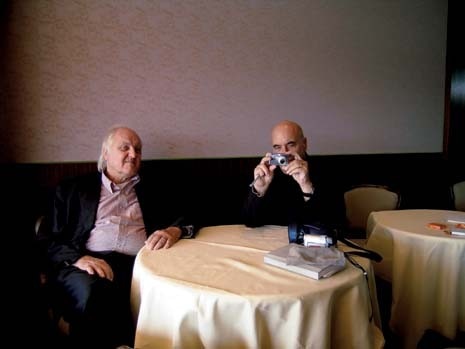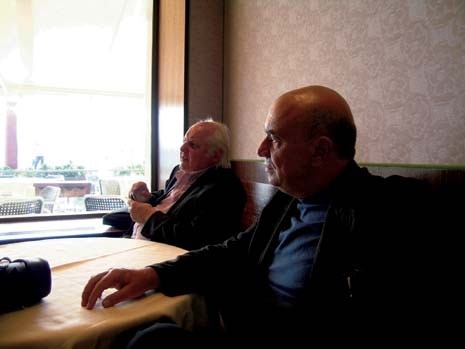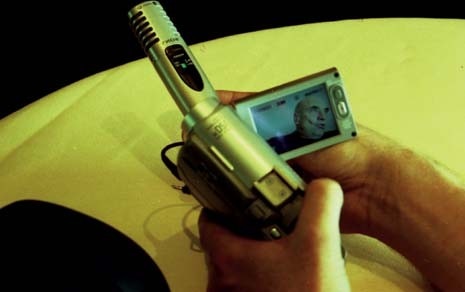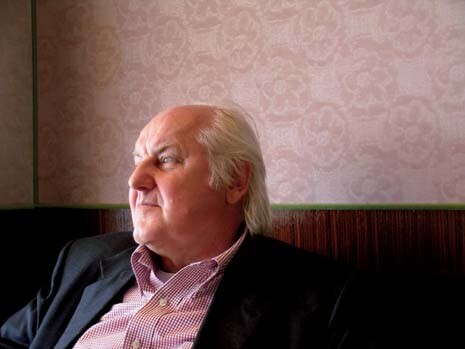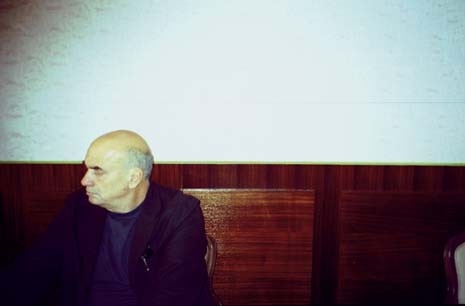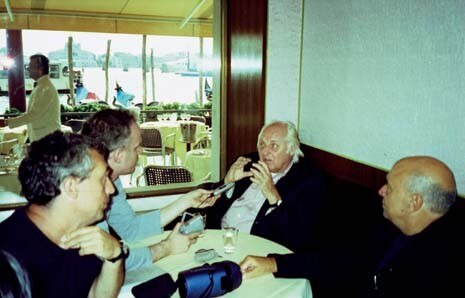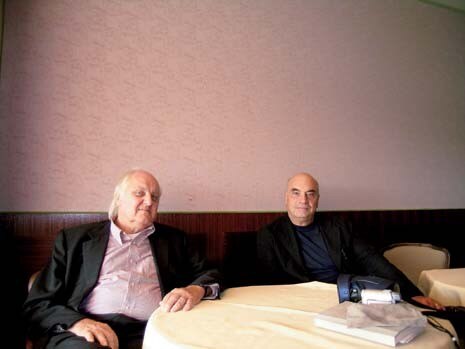Domus: Something that has gained momentum in the last couple of years in the art world is the idea of the artist as curator. In the last Biennale of Visual Arts in Venice, directed by Francesco Bonami, the artists Orozco and Tiravanija were curators of two sections. At the MUMOK in Vienna there is an amazing group show entitled “The Uncanny”, which the artist Mike Kelley has directly curated. But in the architectural field, it has gone the other way, because the last two Biennales have been curated first by a journalist and now this year by a historian, whereas before there was the idea that the Biennale should be directed by an architect.
Hans Hollein, you have not only directed Biennales, but also curated other exhibitions beyond that. So I was wondering if we could start with the question about the architect as curator.
Domus: Could you tell us a little bit about the role curating plays in your practice.
Hans Hollein: We are in an age of crossover, which means we are not pigeonholed as the architect, the curator, the researcher, the historian, the painter or the sculptor. Today we live in a world where we can move between formerly very tight fields. The borders are being erased and this is a very important development. In my particular case, right from the start I was not only dealing with architecture but also with art, developing research on for example Schindler or the Puebloses. But I never wanted to become an art historian. I started with a small exhibition in Vienna and then I went on to the Triennale in Milan, in '68, where I designed the “Austriennale” section. It was my first big approach to an exhibition, not as a designer, but with an overall concept of the installation. I didn't want to be an exhibition designer but be in charge of the whole: the message, the ideas, sometimes the research, and of course the allestimento or design. I think the kind of message you can get across with an exhibition is different from the kind you can achieve with a publication. Maybe when an architect or artist does it, he knows how to build a clearer, but more complex picture.
Massimiliano Fuksas: I completely agree with Hans Hollein because once it was very easy to hold an overall or total position. For example in the Baroque age, there were architects who were also artists and sculptors, and sometimes also writers or documentalists. But now we live in a different period. At the beginning of the century in our profession two figures confronted each other: the architect and the client. Nowadays you don’t have a client but you have project managers, then lighting consultants, water consultants, house techs. You can put together about 100 people to do a project and you no longer have a client. It is normal now that at an exhibition you have a general curator, and then other people who are only temporary curators for parts, who for example organise the spaces. It is a complicated model that in reality doesn’t work. Whereas the similar thing about my exhibition and Hans's exhibition was that we didn’t just deal with the concept but also the organisation of the exhibitions.
Domus: Did you bring in your own team of collaborators for the Biennale in 2000?
Massimiliano Fuksas: Yes, we both did. We produced all the drawings of the exhibition space down to the details: everything was in balance. There wasn’t our concept on one hand, and on the other hand somebody asking if you can put an object in a particular place. The two Biennales after mine were instead characterised by another model, more or less dictated by the fact that somebody with little experience used elements of other people to do different things. Instead, I think that exhibitions are not just collections of works also because today there is a proliferation of magazines, books, websites, and so on. When you put on an exhibition you need to say something new and have a clear hypothesis. Why is it still important to do exhibitions now? Because you can say what’s happening now and show where the conflict is. It’s the same for art exhibitions. After all an exhibition is an installation; it can’t be anything else. You cannot delegate because it is your installation.
Hans Hollein: I think this is an important point because an exhibition is not a three dimensional illustration of an article from a magazine or a book. It’s the conceptual approach that Fuksas also adopted: you have a wonderful list of objects and at the same time you make a declaration of what you’re doing and why. It’s interesting that the art world has also understood that this is a better approach than the situation where only curators take care of exhibitions, with designers just acting as specialists in exhibition techniques.
Domus: In one way you were also planning and designing a certain rhythm of perception for the visitors to your exhibitions. You were designing people’s experience, not simply putting images on walls or models on tables.
Hans Hollein: Sure. In any case we know very well that the container is already content in itself!
Domus: The French artist Dominique Gonzalez- Foerster said that an exhibition has to be a great experience. Can you tell us about the experience of exhibition space and how you see that?
Massimiliano Fuksas: “Sensing the Future - The Architect as Seismograph” by Hans Hollein was an exhibition where you also started to see the creation of architecture outside the canonical field of architecture, which stayed at the centre of attention. In my Biennale I used an identical approach, but symmetrical. I chose a group of architects and first I saw what was happening outside, and then what was happening inside architecture.
Domus: It’s as though both of your Biennales had a kind of double movement…
Massimiliano Fuksas: If you compare the two exhibitions, you can see how both tried to look into the meaning of doing architecture, but also what was happening outside it. We didn't want to just show works and projects, we wanted to show that there was really something dramatic happening. An exhibition isn’t something necessary. You do it because you’re trying to formulate a conceptual synthesis of what you think could happen in a few years, and the way the art and architectural worlds can offer a response. Because art is useful, it’s not only an aesthetic element. Architecture and art can help people.
Domus: Does this mean the exhibition is like a toolbox?
Massimiliano Fuksas: Yes, in a way that’s exactly right. Domus: The Strada Novissima conceived for the 1980 Biennale by Paolo Portoghesi can possibly be seen as a veritable model, or even a sort of anticipation of your idea. This is the idea of using a space that isn’t just the three-dimensional translation of a magazine, but also a lived device that allows the visitor to actually enter a world with their body and senses. It’s not just a physical landscape but also a mental one. Hans Hollein: I think it's important that exhibitions like the Biennale are made for the people, and for a lot of people. You don't make a painting exhibition just for painters or an architectural exhibition just for architects. You make them for an interested and curious public. This is why it’s necessary to transfer things for everybody that must be understood from different angles of knowledge or educational backgrounds. Somebody can still be completely un-knowledgeable about architecture, but when he sees and emerges himself in such an exhibition in the end he has a reaction, he produces a response.
Massimiliano Fuksas: An exhibition has to be a part of your memories. You have to remember it. There are many steps and possibilities to understanding exhibitions. First you go through it, then you see something, you memorise it and finally you use this for something else. You have to find these different levels and play with this in an exhibition. I think that we still really need exhibitions of this type now. I’m not sure we have to end the concept of the huge exhibition.
Domus: The large exhibition was once very important for the information that it circulated. For example, Documenta and the Biennale of Art used to have the function of informing and circulating information on what was happening in the world. But this is no longer necessary because everybody travels and there are scores of magazines that keep the public up to date. It has to be about more than information.
Massimiliano Fuksas: For the exhibition taking place in the Coliseum in Rome called “Form, the modern city and its past”, my studio and I did everything: the concept, the project, the production. In July, we had 370,000 visitors, in August 380,000. But I think its success was not so much down to the theme as much as the involvement of people from different levels. It was a frighteningly stressful job. For me it's much easier to do a building than an exhibition.
Hans Hollein: I agree. Setting up an exhibition takes more effort than doing a skyscraper! If you just divide and delegate all the tasks, it’s difficult to have a compact and convincing atmosphere. But if - even though with great difficulty - you intertwine everything, you produce a further and more innovative experience. On the subject of public reactions, in 1984 I arranged an exhibition in Vienna called “Dream and Reality 1870-1930”. There was a section where I had to show World War I, and so I thought of displaying the bloodstained uniform of archduke Franz Ferdinand from when he was shot in Sarajevo, and I had the painting of the empress beside it. I wanted to show the instance of conflict between systems, generations, and countries. In an exhibition you must also have exhibits that tell you a big story in a nutshell. A lot of people came to see that exhibition.
Domus: So the pieces on display are much more than simple an objects?
Hans Hollein: They are more like icons, or in any case iconic elements.
Domus: At the Biennale all this happens in an incredibly large space, particularly because the Arsenale exhibition space has constantly grown over the last editions. Could you tell us how, with your respective Biennales, you both made this experience and how the Biennale is more than just an accumulation of objects.
Hans Hollein: For the Biennale before Fuksas, we didn’t have much money or time. So after some deliberations, we decided to only concentrate on the Giardini and the Italia Pavilion. The Arsenale wasn’t yet available. At that time we were still negotiating with the admiralty. I think the novelty is that the Arsenale has great potential. You can have a kind of dialectic built into the Giardini and the Arsenale.
Domus: Compared to the previous Biennales, in the last two editions the international pavilions seem to be a cut above, despite their structure belonging to an almost century-old geopolitical vision. It’s as if through experimentation the research has moved from the Italian Pavilion and the Arsenale (used above all as compilation spaces, for cataloguing well-known works) to the international Pavilions.
Massimiliano Fuksas: I think the reason is that there are many countries going through profound change. They are changing their policies and their way of thinking. The national pavilions like the Japanese or American ones are making a feature of this process of change. They move from the glorification of one country to an installation on what they think about a particular theme. The British pavilion of Peter Cook, for example, was very interesting because, as an architect, Cook functions as a curator who selects and assesses the things that seem interesting to him, even if they’re far from the Archigram line.
Hans Hollein: Yes. This is a good answer to the question whether an architect should curate an exhibition, because even though Peter isn’t in complete agreement with all the architects and exhibits, he can understand their quality. His line selects the quality from a higher intellectual point of view. This makes it even more important because if Peter Cook selects something monumental to show, this monumentality – in the context of the exhibition he has curated – suddenly takes on a different tone, because Peter is an architect with his own very clear viewpoint.
Massimiliano Fuksas: A historian or architectural critic tends to organise an exhibition with a scheme. They have a scheme with three, four or five categories and they put the works and authors inside these boxes. For example, in the Biennale that has just been opened, the “Atmosfera” category is amazing in its vagueness… it’s reminiscent of a song by Lucio Battisti from the ‘70s, and for us Italians it sounds a little bit cheap.
Domus: What is your opinion of the current Biennale? What do you find stimulating about it?
Massimiliano Fuksas: It is very difficult. I met Watanabe and he said to me: “I am there, but I don't know where in the Supermarket my project is.” Watanabe is Japanese but with a very British sense of humour. The fact is that there are lots of projects with their material scattered around the halls of the Arsenale. There is a mock-up of a project here, and after fifty metres there are the designs of the same project. Then in another place there is the video of it. It’s a slightly confusing system.
Domus: Armin Linke, you were at the Biennale curated by Massimiliano Fuksas and now at the present Biennale, where you have received a prize. What do you think of this comparison?
Armin Linke: I’ve been very lucky. In this edition I have a very nice place at the entrance to the Italian Pavilion. But, the feeling is that there are a lot of works and projects on offer, maybe too many. I don't know if it’s the architect or the curator’s fault, but there should be a new way of displaying the work to represent it so the people can interact with it. Is it the architect who is responsible for the exposition or the curator who chooses the expository model? For example, it should be considered whether to simply display architecture, or instead show how architecture works, look for a new language to show architecture. In this Biennale I have noticed a problem of visibility. It’s difficult to interpret the presented projects because there is no base of experience.
Domus: Hans Hollein, what do you think of this year’s Biennale?
Hans Hollein: I think that in this Biennale you see the separation between the historian, the designer and the architect. The space is handled very well in the Arsenale. I know this space well, and I remember the different methods of design and organisation in the previous Biennales of architecture and art. I think the idea of design and organisation as such works, and has been very successful. But this space has been filled like a mixed up bag. You don't know how to differentiate the works and the authors. You don't know when things were done, whether they have been executed or just projects. Of course, you could say this is what should be built in the near future. But the Biennale is not just an exhibition for architects. It's an exhibition that you want hundreds of thousands of people to go to. And the problem is that the criteria of project selection don’t come out very well. At the end of the day there is once again the question of the way in which a curator is involved: as an architect, as the director, as a historian or a critic. Depending on your role you automatically see things from a different angle. You need several advices. If you do it as an architect, you act like Peter Cook in the British Pavilion. You select and set up a space on the basis of clear and strong criteria. This is why I think the national pavilions are getting more interesting and ambitious.
Domus: The last Biennale of Art also moved in the same direction. There were 5 or 6 very promising pavilions, whereas in the edition three years ago everything was less interesting. What have your experiences with the Austrian pavilion been?
Hans Hollein: I experimented with many facets in confronting the Biennale. The first was in '72 when I was exhibiting as an artist. I was curating the Austrian pavilions for several years for the Fine Arts Biennale, and then for the Architecture Biennale, and then I became the director. When I was director of the Architecture Biennale I tried very much to convince the different commissioners that they should not all have the same topic, but rather the same frame of mind. In this way you can avoid making an autobiographic exhibition or a patriotic exhibition on your home country. For instance in 2000 I did an exhibition on non-Austrian buildings built in Austria.
Domus: We can remember a film of '72 in which you appeared on a boat in Venice.
Hans Hollein: Yes, that was my installation. I was on a raft, on a chair.
